The Apple Thunderbolt Display Review
by Anand Lal Shimpi on September 23, 2011 2:56 AM EST- Posted in
- Displays
- Mac
- Apple
- Thunderbolt
- Thunderbolt Display
Brightness and Contrast
For brightness, black level, and contrast points, we use the same colorimeter setup described earlier. Specifically, we use an Xrite i1D2 with ColorEyes Display Pro, and take measurements at maximum and minimum brightness of white and black targets. Dynamic contrast is turned off. We also let the panels settle in for a half hour at the respective settings before taking any measurements.
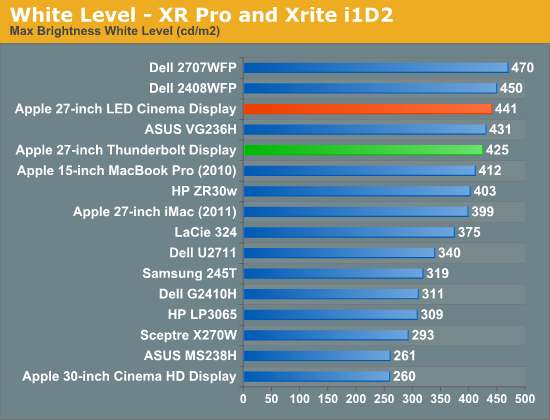
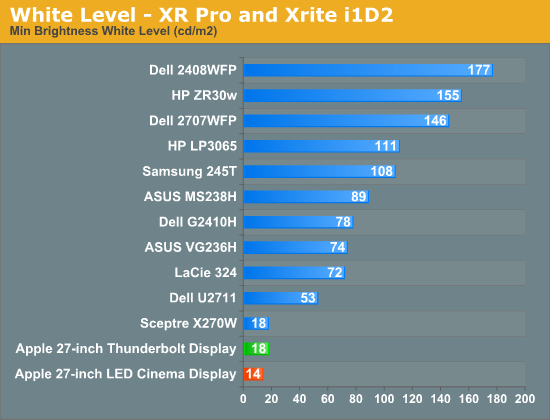
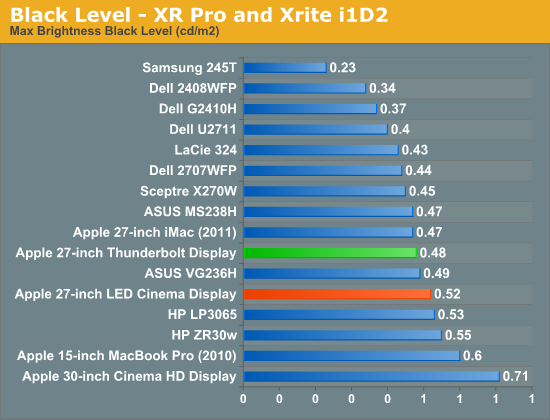
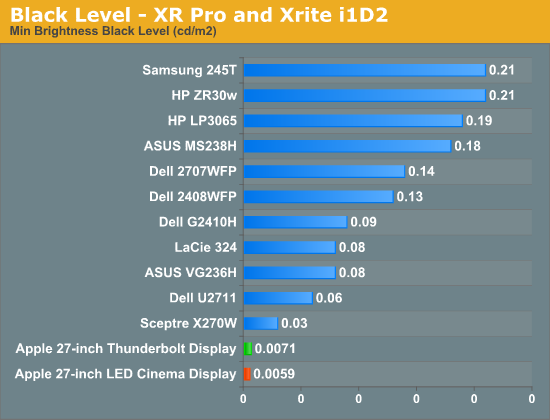
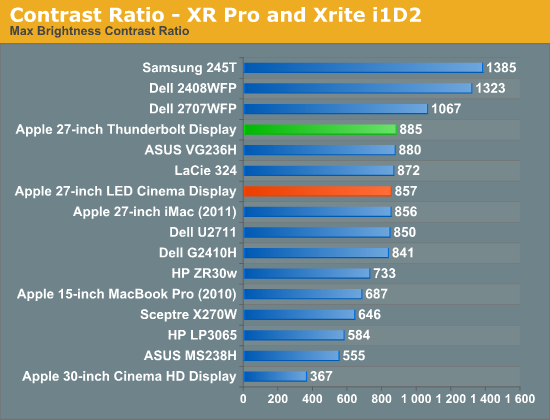
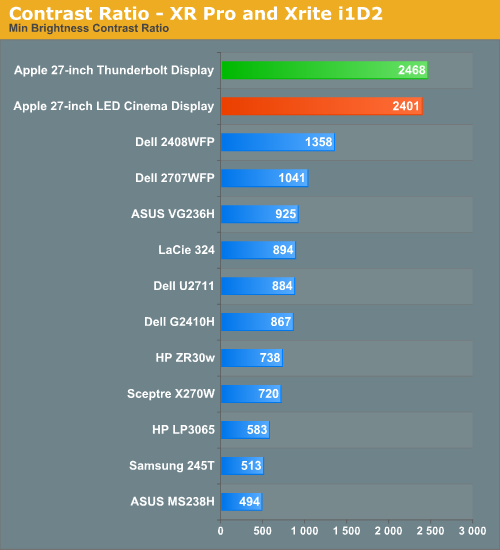
If you were expecting an change in panel quality you won't find it here. The Thunderbolt Display is almost exactly the same as last year's panel but with a bunch of new features.
Brightness Uniformity
In addition to the performance at center, we’ve also added 9-point testing for brightness, both white and black. This is done the same way we measure color uniformity, except we only care about measured intensity. We set the monitor to near 200 nits, and then measure those 9 points.
The Thunderbolt Display performed very well in these tests. The display was very consistent everywhere. Although the center of the panel measured about 8% brighter than the surroundings, it wasn't noticeable in actual use. Brightness uniformity was remarkably consistent through the majority of our measurements, even better than the original 27 we reviewed last year.
White Level Uniformity


Black Level Uniformity

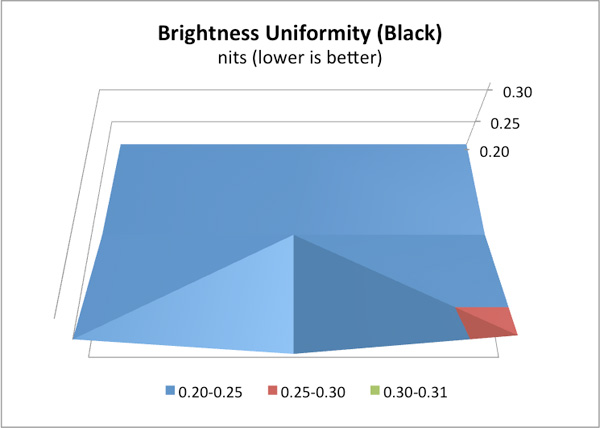
Viewing Angles
The Thunderbolt Display uses an IPS panel which guarantees good horizontal and vertical viewing angles. It doesn't matter how you tilt the display or from what angle you're looking at it (within reason), you'll get a fairly consistent image.















275 Comments
View All Comments
mczak - Friday, September 23, 2011 - link
I'm wondering what the performance would be like? Looks to me like you'd get a far bigger performance hit in this case.Constructor - Friday, September 23, 2011 - link
That would be very interesting indeed.In a discussion over at ars I've been speculating about some of the possible complications with that setup:
http://arstechnica.com/civis/viewtopic.php?t=11558...
(Same user name there.)
Anand, it would be very interesting if you could find out more about the inner workings and the performance consequences of such a combination, possibly confirming or disproving my speculation on the matter.
Over at Macworld they even seem to have made a Cinema display work when plugged in to a Pegasus RAID daisy-chained to a Thunderbolt display. The implications of that and the potential impact on Thunderbolt throughput would be most interesting as well... ;-)
AlexCheng - Friday, September 23, 2011 - link
Sorry guys, but maybe I didn't quite catch it; what exactly is it using as its power supply source? Because it said that the MagSafe port could charge your MacBooks, then where the hell is the cable for its power??Constructor - Friday, September 23, 2011 - link
The display has an ordinary power cable which you'll need to plug into a wall outlet. And the display then powers and charges the MacBok Air/Pro.ltcommanderdata - Friday, September 23, 2011 - link
If Apple goes through with removing the optical drive for the MacBook Pro, hopefully they'll add an optical drive to the Thunderbolt Display. That would make the Thunderbolt Display very complete as a dock.dBoze - Friday, September 23, 2011 - link
Anand,When you mention there is "no analog audio out", I think the inclusion of even analog audio would be a bit of a slap in the face. All Macs in recent history include digital audio through the 1/8" jack via 1/8" TOSLINK, Us Mac users are far too cool for analog ;).
Another solution for digital audio without an extra cable to your MacBook would be using AirPort Express. This will give you a digital or audio connection to your speakers over the network, and you can even plug it into your network via ethernet if your wireless signal isn't too strong. If I recall correctly, you can choose your AirPort Express as the "device for sound output" under the "Output" tab in "Sound" under sys preferences. Of course, you're limited to using AirPlay-compatible applications (iTunes) on the Windows side of things.
Constructor - Friday, September 23, 2011 - link
All recent Macs have both analog (electrical) and digital (optical) audio ports in the same socket. Analog is for convenience, digital is for avoidance of ground loops and of analog signal degradation.An additional audio port (USB/FireWire/Thunderbolt) is possible, if inconvenient.
stanwood - Friday, September 23, 2011 - link
Nice review!A lot of comments about how Apple could have built this display is a way that made it more easily upgradable. This is a PC mentality (which I share). Apple rejects it. Don't waste your time asking for it. If you must have some Mac love, use these 3 simple rules:
1) Buy all your Apple gear in a single release cycle.
1a) Go ahead and upgrade the OS. Those are actually pretty cheap.
2) Use it until you hate it or can't resist getting the new shiny stuff.
3) Give it all to your grandfather, aunt, or Goodwill and return to step 1.
By the time you get to step 3 Apple will have replaced all the important I/Os. There will be no point in trying to upgrade.
mcnabney - Friday, September 23, 2011 - link
Large, high quality displays are expensive, but last a long time. The iMac and displays like this compell people to discard those expensive displays far ahead of their time and likely buy another display of the same size and resolution.My 27" display is on its third computer and it provides better color accuracy than this expensive new one. That is probably my biggest beef with Apple, sending so many nice IPS displays into the trash/closet long before they wear out or become outdated.
slashbinslashbash - Friday, September 23, 2011 - link
Not any more. Starting with the 2010 27" iMac, there was a DisplayPort which was both an input and an output. Now with all the 2011 iMacs having Thunderbolt, they can all be used as displays for other computers with Thunderbolt display output.